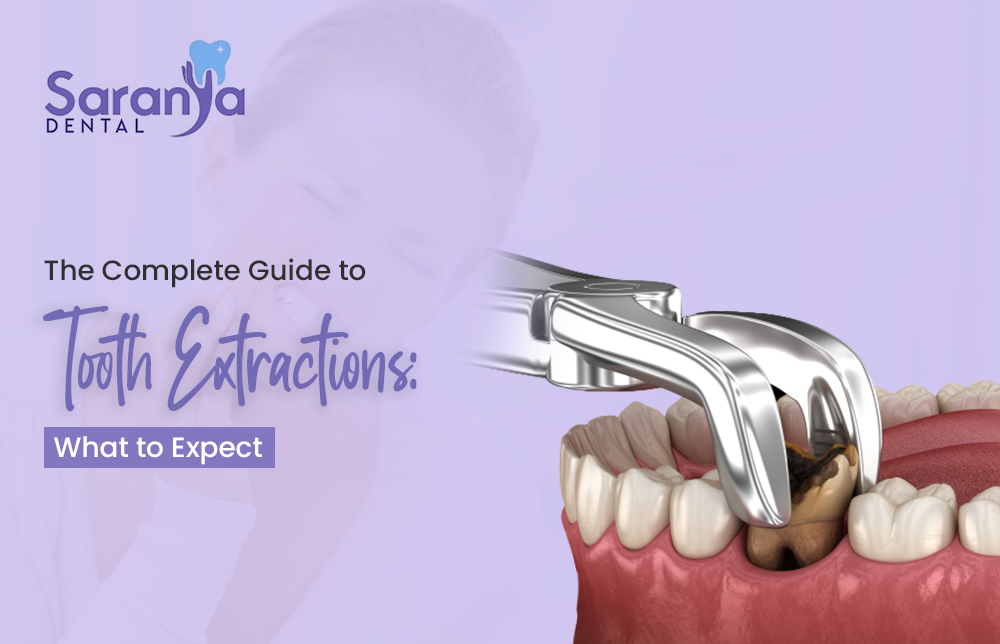Tooth extractions are a common dental procedure, often necessary for a variety of reasons including decay, crowding, or infection. Understanding the process, and what to expect before, during, and after the extraction can help alleviate anxiety and ensure a smoother experience. At Saranya Dental in Toronto, we prioritize patient comfort and care, guiding you through every step of the way. This comprehensive guide will provide you with everything you need to know about tooth extractions.
Why Tooth Extractions Are Necessary
Tooth extractions might be required for several reasons:
- Severe Decay or Damage: When a tooth is extensively decayed or damaged beyond repair, extraction may be the best option to prevent further complications.
- Crowding: Sometimes teeth need to be removed to create space, especially in preparation for orthodontic treatments like braces.
- Infection: If a tooth infection cannot be treated with antibiotics or a root canal, extraction may be necessary to prevent the spread of infection.
- Periodontal Disease: Advanced gum disease can cause teeth to loosen, making extraction the best course of action.
- Impacted Teeth: Wisdom teeth, or third molars, often become impacted (stuck in the gums or jawbone) and may need to be removed.
Before the Extraction
Before your extraction, a thorough examination is conducted to assess the condition of the affected tooth and surrounding tissues. This typically includes:
- X-rays: Dental X-rays help your dentist see the tooth’s position and the bone structure around it.
- Medical History: Inform your dentist about your complete medical history, including any medications you are taking. Conditions such as diabetes, hypertension, and other systemic illnesses can affect the procedure.
- Discussion of Anesthesia Options: Depending on the complexity of the extraction, local anesthesia, sedation, or general anesthesia might be used. Your dentist will discuss the best option for your specific case.
The Extraction Procedure
Tooth extractions can be categorized into two types: simple and surgical.
Simple Extractions
Simple extractions are performed on teeth that are visible in the mouth. This procedure involves:
- Anesthesia: Local anesthesia is administered to numb the area around the tooth.
- Loosening the Tooth: The dentist uses a tool called an elevator to loosen the tooth from its socket.
- Removing the Tooth: Once the tooth is loosened, forceps are used to remove it.
Surgical Extractions
Surgical extractions are more complex and are typically required for teeth that are not easily accessible, such as impacted wisdom teeth. This procedure involves:
- Anesthesia: Local anesthesia is often combined with sedation or general anesthesia.
- Incision: A small incision is made in the gum to access the tooth.
- Bone Removal and Sectioning: Sometimes, the bone around the tooth or the tooth itself needs to be cut into smaller pieces for easier removal.
- Stitches: After the tooth is removed, the incision is usually closed with stitches.
After the Extraction
Proper post-extraction care is crucial for optimal healing and avoiding complications. Here’s what you can expect:
Immediate Aftercare
- Gauze Pad: A gauze pad will be placed over the extraction site to control bleeding. Bite down gently but firmly to help a clot form.
- Pain Management: Over-the-counter pain relievers like ibuprofen can help manage discomfort. Your dentist may also prescribe stronger pain medication if needed.
- Ice Packs: Applying ice packs to the outside of your cheek can reduce swelling and discomfort.
First 24 Hours
- Rest: Avoid strenuous activities for at least 24 hours.
- Diet: Stick to soft foods and avoid hot, spicy, or crunchy foods. Drink plenty of fluids, but avoid using a straw as the suction can dislodge the blood clot.
- Oral Hygiene: Do not rinse your mouth vigorously or brush the extraction site. Instead, gently rinse with a saltwater solution after 24 hours.
Ongoing Care
- Keep the Area Clean: Continue to rinse with a saltwater solution to keep the area clean and promote healing.
- Avoid Smoking and Alcohol: These can interfere with the healing process and increase the risk of complications.
- Follow-Up Appointment: Attend any scheduled follow-up appointments to ensure proper healing and address any concerns.
Potential Complications
While tooth extractions are generally safe, complications can occasionally arise, such as:
- Dry Socket: This occurs when the blood clot at the extraction site is dislodged, exposing the bone and nerves. It can be very painful and requires treatment by your dentist.
- Infection: Signs of infection include fever, severe swelling, and pus. If you experience these symptoms, contact your dentist immediately.
- Nerve Injury: Though rare, nerve damage can occur, leading to numbness or tingling in the lips, tongue, or chin.
Conclusion
Tooth extractions, though sometimes necessary, are a straightforward procedure when handled by experienced professionals. At Saranya Dental in Toronto, we ensure a comfortable and safe experience, from initial consultation to post-extraction care. If you have any concerns or need more information about tooth extractions, feel free to contact us. Your dental health is our priority, and we’re here to help you every step of the way.

